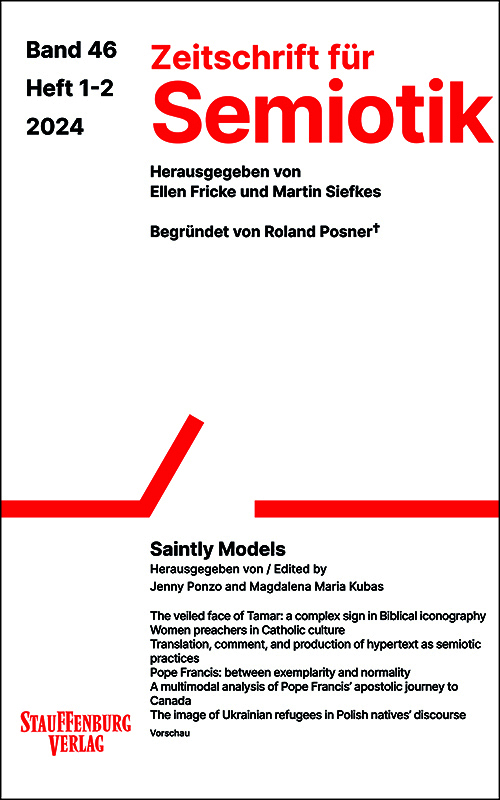Ponzo, Jenny (Hrsg.)
Kubas, Magdalena Maria (Hrsg.)
Zeitschrift für Semiotik / Saintly Models

Verfügbare Version:
Der Artikel erscheint laut Verlag/Lieferant voraussichtlich am 1. August 2025
70,00 €
inkl. MwSt., ggf. zzgl. Versand
Beschreibung
Aus dem Inhalt:Jenny Ponzo and Magdalena Maria Kubas: IntroductionSummary. Saints, just like heroes, leaders, and charismatic figures in general represent systems of social, moral and religious values and models of behavior; they make abstract principles more comprehensible by materializing them in a narrative structure - a story - and by giving them a more human shape that awakens a response which is not only intellectual, but also emotional. Their story, their discourses, but also the discourses about them, therefore, provide an effective figurative representation of abstract norms and values. This special issue focuses on exemplary characters, and most of the collected essays take into consideration in particular saints, exploring their role inside the religious culture. Beside providing an overview of the collected essays, this introduction contextualizes them in the field of the semiotics of religion. Indeed, it proposes a concise presentation of some of the main fields composing the semiotic approach to religious cultures, namely the study of sacred texts, of semiotic ideologies, and of socio-cultural and ethical issues.Zusammenfassung. Heilige repräsentieren - ebenso wie Helden, Führungspersönlichkeiten und charismatische Figuren im allgemeinen - Systeme sozialer, moralischer und religiöser Werte sowie Verhaltensmodelle. Sie machen abstrakte Prinzipien verständlicher, indem sie diese in eine narrative Struktur - eine Geschichte - einbetten und ihnen eine menschlichere Gestalt verleihen, die nicht nur intellektuell, sondern auch emotional anspricht. Ihre Lebensgeschichten, ihre eigenen Diskurse sowie die Diskurse über sie bieten daher eine wirkungsvolle figurative Darstellung abstrakter Normen und Werte. Dieses Themenheft widmet sich exemplarischen Figuren, wobei die meisten der gesammelten Beiträge insbesondere Heilige in den Blick nehmen und ihre Rolle innerhalb der religiösen Kultur untersuchen. Neben einer Übersicht über die versammelten Beiträge ordnet diese Einführung sie in das Forschungsfeld der Semiotik der Religion ein. Sie bietet eine knappe Darstellung einiger zentraler Bereiche des semiotischen Zugangs zu religiösen Kulturen, insbesondere der Analyse heiliger Texte, semiotischer Ideologien sowie soziokultureller und ethischer Fragestellungen.Massimo Leone: Das verschleierte Gesicht der Tamar. Semiotische Schichten in der biblischen Erzählung und der christlichen KunstSummary. The article explores the riveting biblical tale of Tamar from Genesis, a story that weaves together identity, deceit, and acknowledgment. Tamar, sidelined by societal norms, cunningly assumes the guise of a harlot to secure her lineage through her father-in-law, Judah. This strategic deceit, driven by her quest for recognition and continuity, results in the birth of twins, intricately linking her to the genealogy of David and, subsequently, Jesus, highlighting her critical role in the foundation of Judeo-Christian tradition. The article delves into the narrative's core, focusing on the visual trickery and the pivotal moments of recognition, where Tamar's transformations - from a widow to a harlot - play key roles. It scrutinizes the text's vague details about Judah's inability to recognize Tamar, proposing interpretations that have fascinated both artists and scholars over time. The examination extends to the depiction of this narrative in Christian art, where the article singles out the veil as a potent symbol of Tamar's concealed identity. This emblem of disguise is dissected through various artistic renditions, shedding light on broader inquiries about identity, perception, and the essence of deceit.Zusammenfassung. Der Artikel untersucht die fesselnde biblische Geschichte von Tamar aus der Genesis, eine Geschichte, die Identität, Betrug und Anerkennung miteinander verwebt. Tamar, die aufgrund gesellschaftlicher Normen ausgegrenzt wird, gibt sich listig als Hure aus, um ihre Abstammung durch ihren Schwiegervater Juda zu s
Produktdetails
| ISBN/GTIN | 978-3-95809-682-0 |
|---|---|
| Erscheinungsjahr | 2025 |
| Seitenzahl | 143 S. |
| Einbandart | kartoniert |
| Format | 15 x 24 x 7,5 cm |
| Gewicht | 0,22 kg |
Produktsicherheit
Herstellername: Stauffenburg Verlag
Herstelleradresse: August-Bebel-Str. 17, 72072 Tübingen, DE
E-Mail-Adresse: info@stauffenburg.de
Herstelleradresse: August-Bebel-Str. 17, 72072 Tübingen, DE
E-Mail-Adresse: info@stauffenburg.de

